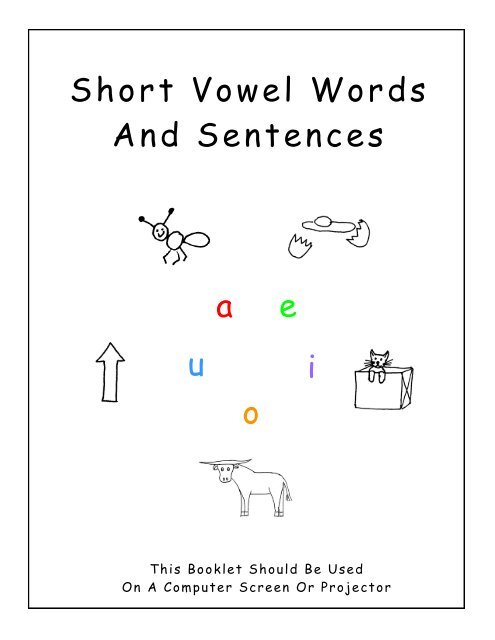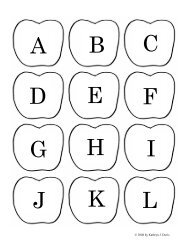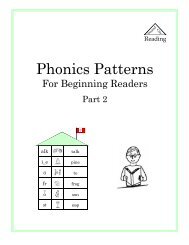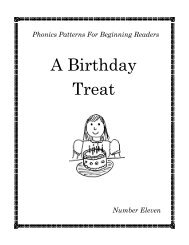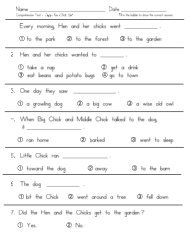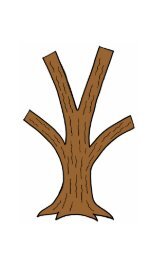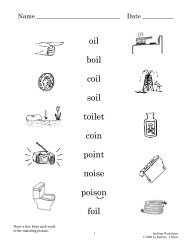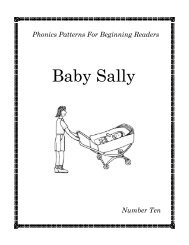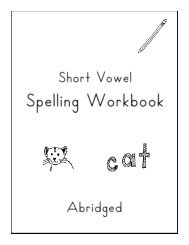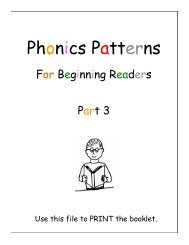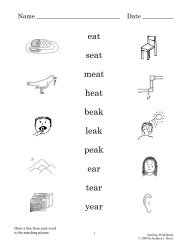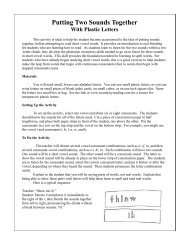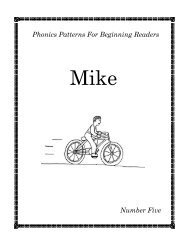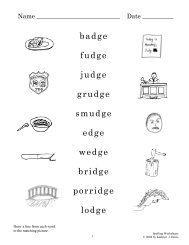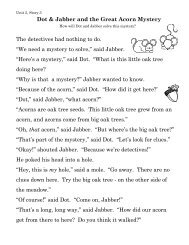Short Vowel Booklet (For Screen) - Sound City Reading
Short Vowel Booklet (For Screen) - Sound City Reading
Short Vowel Booklet (For Screen) - Sound City Reading
- No tags were found...
Create successful ePaper yourself
Turn your PDF publications into a flip-book with our unique Google optimized e-Paper software.
<strong>Short</strong> <strong>Vowel</strong> WordsAnd SentencesaeuoiThis <strong>Booklet</strong> Should Be UsedOn A Computer <strong>Screen</strong> Or Projector
<strong>Short</strong> <strong>Vowel</strong> <strong>Sound</strong>sA a E e I i O o U uSight Word Reviewazzis as IAzzhis haszwasEntire contents © 2010 By Kathryn J. Davis7223 Cedar Lane DriveGermantown, TN 38138(901) 737-4466All rights reserved.<strong>Sound</strong><strong>City</strong><strong>Reading</strong>Permission is hereby granted to teachers, parents, and tutors to reproducestudent materials in this book for individual or classroom use. Permission isgranted for school-wide reproduction of materials. Commercial reproduction isprohibited.Printed in the United States of America
Table of ContentsHow to use this book ................................................................................................ 4The Robot Game ........................................................................................................ 6Putting Two <strong>Sound</strong>s Together Using Plastic Letters ....................................... 8<strong>Sound</strong> Blending - Decoding Two <strong>Sound</strong>s ............................................................. 11The Blueberry and Raspberry Games ................................................................. 14Using Plastic Letters To Spell Three Letter Words ..................................... 15Learning To Separate Words Into <strong>Sound</strong>s ....................................................... 16<strong>Short</strong> A Words<strong>Short</strong> a words, part 1 (continuous consonants at the beginning) ............... 19<strong>Short</strong> a words, part 2 (stopped consonants at the beginning) ..................... 21Sight word: a ........................................................................................................... 23Sight word: has....................................................................................................... 27Sight word: was ....................................................................................................... 31<strong>Short</strong> I Words<strong>Short</strong> i words, part 1 (continuous consonants at the beginning) ................ 35<strong>Short</strong> i words, part 2 (stopped consonants at the beginning)..................... 37Sight word: I ........................................................................................................... 39Sight word: is .......................................................................................................... 43Sight word: his ....................................................................................................... 45Statements .............................................................................................................. 47Questions ................................................................................................................. 49<strong>Short</strong> O Words<strong>Short</strong> o words, part 1 (continuous consonants at the beginning) ................ 51<strong>Short</strong> o words, part 2 (stopped consonants at the beginning) .................... 53<strong>Short</strong> U Words<strong>Short</strong> u words, part 1 (continuous consonants at the beginning) ............... 63<strong>Short</strong> u words, part 2 (stopped consonant at the beginning)...................... 65Suffix study: _s with verbs ................................................................................ 73<strong>Short</strong> E Words<strong>Short</strong> e words, part 1 (continuous consonants at the beginning) ............... 75<strong>Short</strong> e words, part 2 (stopped consonants at the beginning) ................... 77Suffix study: _s with verbs ................................................................................ 85Suffix study: _s with nouns ................................................................................. 91Suffix study: using 's ........................................................................................... 97Alphabet Chart ...................................................................................................... 101Consonant Chart for sound blending activity ................................................. 105© 2011 by Kathryn J. Davis 3<strong>Short</strong> <strong>Vowel</strong> Words And Sentences
10. An umbrella over a vowel is a signal to use the u/umbrella sound (short u sound) forthat vowel, instead of its usual sound.11. Sight words have parts that can not be sounded out in the usual way. On eachsight word page, show the student how to pronounce the sight words, and have thestudent read the sentences. After finishing this booklet, students should be ableto read all of the sight words on the inside of the front cover.12. The short vowel words are taught in this order: short a words, short i words, shorto words, short u words, short e words. Each set of these is divided into twogroups. The first group of words starts with continuous consonants. The secondgroup of words starts with stopped consonants.13. When you pronounce a continuous consonant, it is possible to hold the sound for aperiod of time. This makes it much easier for a student to connect the firstconsonant sound in the word to the vowel sound that comes after it. I use theseconsonants in the first group: f, h, l, m, n, qu, r, s, v, w, x, y, and z. (When youpronounce the consonants qu and x, you can actually hear two parts to the sound.The letter qu sounds like /kw/, and the letter x sounds like /ks/. I include theseletters in the continuous consonants since the second part of the sound can beheld.)14. Stopped consonants cannot be held. The sound disappears after you pronounce it.I use these stopped consonants: b, c, d, g, j, k, p, and t. These words are harderfor beginners to read because it is more difficult to connect the sound of thefirst consonant and the following vowel smoothly.15. I’ve put words that begin with the same consonant together on the page. <strong>For</strong>example, the words can, cat, cab, and cap will appear together. This repetitionhelps the student master oral blending of the first consonant and the followingvowel. It also helps the student learn to watch carefully and be aware of theending consonants, since they change from one word to the next.16. Beginning readers master decoding skills at different rates. It is important forstudents to take ownership over the need to practice reading and rereading thematerial until it can be read smoothly, with good expression. Many students havedifficulty getting started, but go on to master the material very well.17. If a student has difficulty connecting the separate letter sounds together to formwords, play the games suggested in this book on a regular basis. The blueberryand raspberry games will be available at www.soundcityreading.com.18. A workbook is available for written practice with short vowel words.© 2011 by Kathryn J. Davis 5<strong>Short</strong> <strong>Vowel</strong> Words And Sentences
Playing The Robot Game:Connecting <strong>Sound</strong>sTo Make Wordsc......a......tUse the picture pages in this book to play a guessing game to prepare studentsto read new words. The pictures are on the left side, and the new words to read areon the right side. The pictures and words match, but they are not in the same order.This makes it easier to play the game. During the game, the teacher will say the words"like a robot," by pronouncing each sound in the word separately.This activity is ideal to help the student become accustomed to the idea of puttingsounds together to form words. It is ideal for beginners or students who are havingdifficulty learning to read.Part One - Finding the Pictures1. The student looks at the pictures. The teacher looks at the words.2. The teacher says the sounds in the first word, going from left to right, with apause between each sound. <strong>For</strong> example, if the word is fan, the teacher would say"f.......a.......n." Don't point to the letters, just say the sounds. Be sure each soundis completely separate. <strong>For</strong> example, don't say "fa......n" or "f.....an." Also, be carefulnot to add the "uh" sound to the consonants, "fuh.....a.....nuh." Be sure to pronouncedouble letters as a single sound, for example "m......i.......ss."3. The student looks at all of the pictures, finds the picture of the fan, points to it,and says the word in the normal way (not with separated sounds).4. The teacher says the sounds for the next word, and then the remaining words, oneat a time, until all have been completed.5. The student responds in the same way each time, finding the picture, pointing to it,and saying the word.© 2011 by Kathryn J. Davis 6<strong>Short</strong> <strong>Vowel</strong> Words And Sentences
Part Two - Finding the Words1. This time, both the student and the teacher look at the words.2. The teacher says each word "like a robot," just as before, except this time goesout of order, selecting words randomly on the page.3. The student looks at all of the words on the page, listens to the sounds, and findsthe matching word. He must look carefully to find the word with the correct beginning,middle, and ending sound. Then the student points to the word and says itin the regular way. If the student tries to say the separate sounds, remind him to"say it fast."CommentsThis exercise introduces new vocabulary to the students without the burden ofhaving to decode new words, allowing them to focus on meaning. It also helps studentslearn to hear the separate sounds in each word, and then stick them togetherto reassemble the word. This is an important skill that develops a student's ability tospell and decode new words.(Note: The pages from the pdf file for this book will be available atwww.soundcityreading.com. They can be displayed on a large screen using a projector.The game can be played with the entire class from the screen.)© 2011 by Kathryn J. Davis 7<strong>Short</strong> <strong>Vowel</strong> Words And Sentences
Putting Two <strong>Sound</strong>s TogetherUsing Plastic LettersThis activity is ideal to help the student become accustomed to the idea ofputting sounds together. It is ideal for beginners or students who are havingdifficulty learning to read.MaterialsYou will need some system of small, moveable alphabet letters. Use lower caseletters. You can use small plastic letters. Or you can write letters on small pieces ofblank index cards, on small cubes, or on one inch square tiles. Write one letter of thealphabet on each card, cube, or tile. Store the items in a small box or bag.Setting Up the ActivityTo set up the activity, select one vowel and about six or more consonants. Pickout letters that have been taught. Cut a piece of construction paper in halflengthwise, and place both paper strips in front of the student, one above the other.Put the consonants in a row on the top strip and the vowel on the bottom strip. <strong>For</strong>example, you might use the vowel i and consonants t, h, l, n, w, and b.To Do the ActivityThe teacher will dictate several vowel-consonant combinations, such as it, il,in, etc. Each combination will have two sounds. One sound will be a vowel sound. Theother sound will be a consonant sound. The letter to show the vowel sound will bealready in place on the lower strip of construction paper. The student is to listen forthe consonant sound, select the correct consonant letter, and put it beside the vowel.Then the student pronounces the letter combination orally.Explain to the student that you will be saying parts of words, not real words.We can call these "silly sounds." Explain that being able to spell these parts will helpthem learn to spell and read real words.Be sure to use the short vowel sounds when you do this exercise: a/ant, e/egg,i/in, o/ox, u/up.You can see a typical sequence on the next page.© 2011 by Kathryn J. Davis 8<strong>Short</strong> <strong>Vowel</strong> Words And Sentences
Teacher: “Show me ib.”Student: Selects b and places it immediately to the right of the i, then blends thesounds together from left to right, without a break between sounds: “ib.”Teacher: “Show me il.”Student: Puts b back in line above the i, selects l, and places it to the right of i. Blendsthe sounds together from left to right: il. (Notice you are not spelling the word ill, justthe work chunk il.)Teacher: “Show me in.”Student: Puts b back in line above the i, selects n, and places it to the right of the i.Says in. (This just happens to be a real word. The student may or may not notice this.)Teacher: “Show me it.The teacher and student continue in the same way until all of the possible vowelconsonantcombinations have been done. You won’t use h or w after the i, since ih andiw are difficult to pronounce and these combinations are not normally seen in words.You will use the letters h and w shortly as beginning sounds are paired with i.Next do the same activity, but this time say letter combinations that have theconsonant sound first. Show me hi. Show me bi, ti, li, ni, etc. Don't forget to use theshort vowel sound for all letter combinations.© 2011 by Kathryn J. Davis 9<strong>Short</strong> <strong>Vowel</strong> Words And Sentences
This process of building two-letter sound combinations helps students "break thecode" and understand that speech is made up of smaller sounds. Instead of startingwith three-letter words, its much easier for students to just concentrate on twosounds at a time. Being able to see the letters and physically move them as they hearthe combined sounds and build them opens the door to a real understanding of thestructure of words.CommentI worked with my niece years ago when she was in kindergarten. She workedhard to learn her alphabet letters. At first she couldn’t remember which was whichand couldn’t remember the sounds. I wrote the sound story (available on the website)for her, and using posters with the letters and sound pictures, she learned thoseletters like a pro. But she still did not grasp the concept that the letter sounds couldbe put together to form meaningful words. One day, as I was trying to teach her tobuild three letter words with plastic letters with no luck, we invented this activitytogether. Doing just two sounds at a time made a huge difference. The light bulb wenton during the lesson. From then on she made steady progress, and went on to makestraight A’s in first grade. She is now doing well in her Honor’s reading classes inmiddle school, and most important, she loves to read.© 2011 by Kathryn J. Davis 10<strong>Short</strong> <strong>Vowel</strong> Words And Sentences
<strong>Sound</strong> Blending - Decoding Two <strong>Sound</strong>sAfter the student has practiced putting two sounds together using plasticletters, you can do this activity to teach the reverse skill. This activity is morechallenging, since the student is going from symbol to sound instead of sound tosymbol. The student must look at a pair of letters and say both sounds, sliding thesounds together smoothly. The student learns to connect symbols with speech.MaterialsTo do this exercise, you can use the sound blending materials available on thissite, or create your own.You’ll need two separate cards for each vowel, like the i cards shown below.You will use these cards with two columns of consonants. These materials use largeprint so they can be used with a group.Print the two consonant columns on white cardstock. I print the vowels oncolored cardstock, using red for a, light green for e, light purple for i, orange for o,light blue for u. Put the two consonant columns on an easel or clip to a pocket chartor chalkboard.Setting Up the ActivityYou will use two vowel cards and the consonant strips. You will hold a vowel card tothe right or left of each consonant and move the card down the column.To Do the ActivityTake the vowel you want to work with, and slide it down one side of thecolumn. Students will blend the sounds for each letter pair aloud. You can go downthe left side first and then the right, or the other way around. If you are using ion the left side first, the student would watch carefully as you move the i from oneletter to the next and say, “ib, ic, id, if, ig, (skip h), ij, ik, il, im, in, ip, (skip qu and r),is, it, iv, (skip w), ix, (skip y), iz.” Then, as you move the other vowel card down theright side of each column, the student would say, “bi, (skip c), di, fi, gi, hi, ji, ki, li,mi, ni, pi, qui, ri, si, ti, vi, wi, (skip x), yi, zi.” After students master the processwith one short vowel, you can repeat the process for the other vowels. Rememberto use just the short vowel sounds for now.© 2011 by Kathryn J. Davis 11<strong>Short</strong> <strong>Vowel</strong> Words And Sentences
CommentsAfter a move to a new city, I spent some time tutoring before going back to theclassroom full time. I volunteered to work with students in my cousin’s first gradeclass. She gave me four to six students to teach in a small group for about an hourat a time. I was ready to teach them to read short vowel words, but found thatwas way beyond what they were able to do. We had to start with beginning andending sounds. I was tutoring a little girl at my house, with the same problem. Oneday I devised this activity, and she responded well to it, so I brought it to schoolto work with my cousin’s group. It was so difficult for them that we worked at itfor several lessons before they could do it themselves. It was so hard for thosechildren that I asked the school speech teacher if it was appropriate to use withthem, and she approved. After the students mastered this activity, we went on toread three letter short-vowel words, and they were able to decode themcomfortably. We played a lot of games decoding three letter short vowel words.By the end of the year they had improved dramatically, and were learning twoletterphonogram patterns and reading the related sentences and stories.© 2011 by Kathryn J. Davis 13<strong>Short</strong> <strong>Vowel</strong> Words And Sentences
Using Plastic Letters To Spell Three Letter WordsThis activity works well with one to six students, or even a whole class if you haveenough sets of letters. Instead of using the whole alphabet at one time, each student willtake about six or eight letters to work with, designated by the teacher. Students spellwords dictated by the teacher with the letters. They do not write the words on paper, whichallows the spelling to proceed rapidly from one word to the next.Make a list ahead of time of the words you want to teach. Then list all of the lettersthat will be needed.Have the students sit around a table or at their desks. Ahead of time, cut sheets ofconstruction paper lengthwise to form two pieces. Each student takes two pieces and placesone above the other in front of them on the table. The top sheet is the "letter bank." Thebottom sheet is the spelling area.Give each student a box with two each of all the alphabet letters. Say the sound ofeach letter the students will need, one at a time. When they hear each sound, studentsshould find the letter needed and place it on the top sheet of construction paper. Explain tothe students that this is their letter bank. When all the needed letters have been placed inthe letter bank, you’re ready to begin.Say each word slowly and distinctly and coach the students to listen for each soundand place the letters accordingly from left to right. Model as needed. Each student willselect the letters needed from his own "letter bank," and spell the word in the spelling area.Check each student’s work and have them listen again and correct as needed. Have studentsplace the letters back into their letter banks before dictating another word.After the students become comfortable with the process, go through a number ofwords as quickly as the students can spell them.Sometimes, have the students leave a word that they spelled in their spelling area,and ask them to change one letter to create a new word. <strong>For</strong> example, if the student hasspelled cat, say, "Change just the beginning letter to make the word sat." Or say, "Changethe last letter to make the word cap." Or say, "Change the middle letter to make the wordcut." Soon, the students won't need to be cued. Just say a string of words as follows, oneat a time, and have students replace or remove letters as needed to spell the word: cat, can,fan, fax, tax, ax, ox, box.This activity greatly enhances the student's phonemic awareness. He is matchingletters with the sounds he hears in words. He is learning to sequence, add, remove, andsubstitute sounds in known words to make new words.Note: Before you do this exercise, first be surethe students can do the two-letter exercise withplastic letters, as described on a previous page.© 2011 by Kathryn J. Davis 15<strong>Short</strong> <strong>Vowel</strong> Words And Sentences
Materials:Learning To Separate Words Into <strong>Sound</strong>s(Preparation <strong>For</strong> Spelling)Use any of the picture pages in this book that are used to introducethe short vowel words. This is strictly a sound game; you won't useany letters. You’ll need three small objects. Colored cubes or teddybear counters are available from school supply stores. If these arenot available, you could use other items, such as buttons, dried beans,bottle caps, etc. Small slips of paper about one inch square will work,too. <strong>For</strong> three-sound words, I like to use three different colors, linedup from left to right in this order - green, yellow, and red. I talkabout the colors on a stoplight with the student. Green means go,yellow means slow down, and red means stop. When you work with twosoundwords, use only two of the objects.To do the activity:The teacher points to a picture. Tell the student the word if hedoesn’t recognize the picture. Show the student how to break theword apart into separate sounds. Say each sound separately. As yousay each sound, push a cube forward about an inch, going from left toright. Each cube will represent a sound. Have the student repeat theprocess with the same word. Be sure the sounds are completelyseparate. <strong>For</strong> example, cat should be c....a.....t, not ca.....t, and notc.....at. Continue in the same way for each picture. The goal is for thestudent to look at a picture, move the cubes, and separate the wordinto distinct sounds without help from you. Be sure to explain themeanings of any unfamiliar words.© 2011 by Kathryn J. Davis 16<strong>Short</strong> <strong>Vowel</strong> Words And Sentences
c..........a............t© 2011 by Kathryn J. Davis 17<strong>Short</strong> <strong>Vowel</strong> Words And Sentences
© 2011 by Kathryn J. Davis 18<strong>Short</strong> <strong>Vowel</strong> Words And Sentences
A.aB. C. D.E. F. G.H. I. J.© 2011 by Kathryn J. Davis 19<strong>Short</strong> <strong>Vowel</strong> Words And Sentences
1.2.3.4.5.6.7.8.9.10.af a nm a pm a ns a ts a dh a th a dn a pr a na ddfanmapmansatsadhathadnapranadd© 2011 by Kathryn J. Davis 20<strong>Short</strong> <strong>Vowel</strong> Words And Sentences
A.aB. C. D.E. F. G.H. I. J.© 2011 by Kathryn J. Davis 21<strong>Short</strong> <strong>Vowel</strong> Words And Sentences
1.2.3.4.5.6.7.8.9.10.ac a nc a tp a np a ssb a db a tg a sd a dj a mt a gcancatpanpassbadbatgasdadjamtag© 2011 by Kathryn J. Davis 22<strong>Short</strong> <strong>Vowel</strong> Words And Sentences
AaSightWordsA manA fanA vana rama hata sax© 2011 by Kathryn J. Davis 23<strong>Short</strong> <strong>Vowel</strong> Words And Sentences
AaSightWordsAmanAfanAvanaramahatasax© 2011 by Kathryn J. Davis 24<strong>Short</strong> <strong>Vowel</strong> Words And Sentences
AaSightWords1. A man ran.2. A rat sat.3. A ram ran.4. A man had a hat.5. Sam ran a lap.6. Max had a nap.© 2011 by Kathryn J. Davis 25<strong>Short</strong> <strong>Vowel</strong> Words And Sentences
AaSightWords1. A man ran.2. A rat sat.3. A ram ran.4. A man had a hat.5. Sam ran a lap.6. Max had a nap.© 2011 by Kathryn J. Davis 26<strong>Short</strong> <strong>Vowel</strong> Words And Sentences
zhasSightWords1. A man has an ax.2. Sam has a sax.3. A man has a van.4. Nan has a fan.5. A man has a hat.© 2011 by Kathryn J. Davis 27<strong>Short</strong> <strong>Vowel</strong> Words And Sentences
zhasSightWords1. A man has an ax.2. Sam has a sax.3. A man has a van.4. Nan has a fan.5. A man has a hat.© 2011 by Kathryn J. Davis 28<strong>Short</strong> <strong>Vowel</strong> Words And Sentences
zhasSightWords1. Pam has a pan.2. Dan has a cat.3. Pat has a bat.4. Sam has a cap.5. Sam has a gap.© 2011 by Kathryn J. Davis 29<strong>Short</strong> <strong>Vowel</strong> Words And Sentences
zhasSightWords1. Pam has a pan.2. Dan has a cat.3. Pat has a bat.4. Sam has a cap.5. Sam has a gap.© 2011 by Kathryn J. Davis 30<strong>Short</strong> <strong>Vowel</strong> Words And Sentences
zwasSightWords1. Max was mad.2. Sam was sad.3. Nan was at a lab.4. A cat was fat.© 2011 by Kathryn J. Davis 31<strong>Short</strong> <strong>Vowel</strong> Words And Sentences
zwasSightWords1. Max was mad.2. Sam was sad.3. Nan was at a lab.4. A cat was fat.© 2011 by Kathryn J. Davis 32<strong>Short</strong> <strong>Vowel</strong> Words And Sentences
zwasSightWords1. Dan was sad.2. A rat was fat.3. A cat was bad.4. Dad was mad.© 2011 by Kathryn J. Davis 33<strong>Short</strong> <strong>Vowel</strong> Words And Sentences
zwasSightWords1. Dan was sad.2. A rat was fat.3. A cat was bad.4. Dad was mad.© 2011 by Kathryn J. Davis 34<strong>Short</strong> <strong>Vowel</strong> Words And Sentences
A.iB. C. D.E. F. G.H. I. J.© 2011 by Kathryn J. Davis 35<strong>Short</strong> <strong>Vowel</strong> Words And Sentences
1.2.3.4.5.6.7.8.9.10.is i ts i xh i llh i th i mw i nf i llm i ssi ni tsitsixhillhithimwinfillmissinit© 2011 by Kathryn J. Davis 36<strong>Short</strong> <strong>Vowel</strong> Words And Sentences
A.iB. C. D.E. F. G.H. I. J.© 2011 by Kathryn J. Davis 37<strong>Short</strong> <strong>Vowel</strong> Words And Sentences
1.2.3.4.5.6.7.8.9.10.ib i gb i tb i llk i dk i ssp i np i gp i llt i pd i gbigbitbillkidkisspinpigpilltipdig© 2011 by Kathryn J. Davis 38<strong>Short</strong> <strong>Vowel</strong> Words And Sentences
ISightWords1. I win.2. I can mix it.3. I miss him.4. I hid.5. I will sip it.6. I lit it.© 2011 by Kathryn J. Davis 39<strong>Short</strong> <strong>Vowel</strong> Words And Sentences
ISightWords1. I win.2. I can mix it.3. I miss him.4. I hid.5. I will sip it.6. I lit it.© 2011 by Kathryn J. Davis 40<strong>Short</strong> <strong>Vowel</strong> Words And Sentences
ISightWords1. I can zip it.2. I will hit it.3. I can dig it.4. I am a kid.5. I am a pig.© 2011 by Kathryn J. Davis 41<strong>Short</strong> <strong>Vowel</strong> Words And Sentences
ISightWords1. I can zip it.2. I will hit it.3. I can dig it.4. I am a kid.5. I am a pig.© 2011 by Kathryn J. Davis 42<strong>Short</strong> <strong>Vowel</strong> Words And Sentences
zisSightWords1. Jan is ill.2. Dan is six.3. Pam is at a dam.4. A man is in a cab.5. It is bad.6. Jill is at a lab.© 2011 by Kathryn J. Davis 43<strong>Short</strong> <strong>Vowel</strong> Words And Sentences
zisSightWords1. Jan is ill.2. Dan is six.3. Pam is at a dam.4. A man is in a cab.5. It is bad.6. Jill is at a lab.© 2011 by Kathryn J. Davis 44<strong>Short</strong> <strong>Vowel</strong> Words And Sentences
zhisSightWords1. It is his bib.2. It is his kit.3. It is his cat.4. It is his mitt.5. Dad is in his van.6. Sam will wax his van.© 2011 by Kathryn J. Davis 45<strong>Short</strong> <strong>Vowel</strong> Words And Sentences
zhisSightWords1. It is his bib.2. It is his kit.3. It is his cat.4. It is his mitt.5. Dad is in his van.6. Sam will wax his van.© 2011 by Kathryn J. Davis 46<strong>Short</strong> <strong>Vowel</strong> Words And Sentences
Statements1. Bill will fix it.2. Kim will kiss him.3. A big pig has a wig.4. It bit him.5. Pam will miss it.6. Jan did a kip.© 2011 by Kathryn J. Davis 47<strong>Short</strong> <strong>Vowel</strong> Words And Sentences
Statements1. Bill will fix it.2. Kim will kiss him.3. A big pig has a wig.4. It bit him.5. Pam will miss it.6. Jan did a kip.© 2011 by Kathryn J. Davis 48<strong>Short</strong> <strong>Vowel</strong> Words And Sentences
Questions1. Did Pat dig it?2. Will Kim win?3. Did Jim miss?4. Can it hiss?5. Is it big?6. Did Sam win?© 2011 by Kathryn J. Davis 49<strong>Short</strong> <strong>Vowel</strong> Words And Sentences
Questions1. Did Pat dig it?2. Will Kim win?3. Did Jim miss?4. Can it hiss?5. Is it big?6. Did Sam win?© 2011 by Kathryn J. Davis 50<strong>Short</strong> <strong>Vowel</strong> Words And Sentences
A.oB. C. D.E. F. G.H. I. J.© 2011 by Kathryn J. Davis 51<strong>Short</strong> <strong>Vowel</strong> Words And Sentences
1.2.3.4.5.6.7.8.9.10.oh o ph o tm o mm o pl o gl o tf o xn o to no ffhophotmommoploglotfoxnotonoff© 2011 by Kathryn J. Davis 52<strong>Short</strong> <strong>Vowel</strong> Words And Sentences
A.oB. C. D.E. F. G.H. I. J.© 2011 by Kathryn J. Davis 53<strong>Short</strong> <strong>Vowel</strong> Words And Sentences
1.2.3.4.5.6.7.8.9.10.op o tp o pj o gj o bd o td o gd o llg o tt o pb o xpotpopjogjobdotdogdollgottopbox© 2011 by Kathryn J. Davis 54<strong>Short</strong> <strong>Vowel</strong> Words And Sentences
Sentences1. Mom will mop.2. Moss is on a log.3. It can hop.4. A man has a rod.5. Mom is hot.6. Rob is not hot.© 2011 by Kathryn J. Davis 55<strong>Short</strong> <strong>Vowel</strong> Words And Sentences
Sentences1. Mom will mop.2. Moss is on a log.3. It can hop.4. A man has a rod.5. Mom is hot.6. Rob is not hot.© 2011 by Kathryn J. Davis 56<strong>Short</strong> <strong>Vowel</strong> Words And Sentences
Sentences1. A bat is on a mat.2. A hat is on a cat.3. A tag is on a bag.4. A cat is on a mat.5. Mom is mad.6. A hog is fat.© 2011 by Kathryn J. Davis 57<strong>Short</strong> <strong>Vowel</strong> Words And Sentences
Sentences1. A bat is on a mat.2. A hat is on a cat.3. A tag is on a bag.4. A cat is on a mat.5. Mom is mad.6. A hog is fat.© 2011 by Kathryn J. Davis 58<strong>Short</strong> <strong>Vowel</strong> Words And Sentences
Sentences1. A dot is on a pot.2. A dog is on a log.3. Bob has a box.4. Bill is on a hill top.5. A fox got on a box.6. Rob did his job.© 2011 by Kathryn J. Davis 59<strong>Short</strong> <strong>Vowel</strong> Words And Sentences
Sentences1. A dot is on a pot.2. A dog is on a log.3. Bob has a box.4. Bill is on a hill top.5. A fox got on a box.6. Rob did his job.© 2011 by Kathryn J. Davis 60<strong>Short</strong> <strong>Vowel</strong> Words And Sentences
Sentences1. A dog is hot.2. A lid is on a pot.3. A cat is on a box.4. Rob can jog.5. A pot is hot.6. Tom has a pot.Mom has a box.© 2011 by Kathryn J. Davis 61<strong>Short</strong> <strong>Vowel</strong> Words And Sentences
Sentences1. A dog is hot.2. A lid is on a pot.3. A cat is on a box.4. Rob can jog.5. A pot is hot.6. Tom has a pot.Mom has a box.© 2011 by Kathryn J. Davis 62<strong>Short</strong> <strong>Vowel</strong> Words And Sentences
A.uB. C. D.E. F. G.H. I. J.© 2011 by Kathryn J. Davis 63<strong>Short</strong> <strong>Vowel</strong> Words And Sentences
1.2.3.4.5.6.7.8.9.10.ur u nr u gs u ms u nh u gn u tf u nm u du pu srunrugsumsunhugnutfunmudupus© 2011 by Kathryn J. Davis 64<strong>Short</strong> <strong>Vowel</strong> Words And Sentences
A.uB. C. D.E. F. G.H. I. J.© 2011 by Kathryn J. Davis 65<strong>Short</strong> <strong>Vowel</strong> Words And Sentences
1.2.3.4.5.6.7.8.9.10.ub u gb u sb u zzc u pc u tc u bt u bp u pg u md u gbugbusbuzzcupcutcubtubpupgumdug© 2011 by Kathryn J. Davis 66<strong>Short</strong> <strong>Vowel</strong> Words And Sentences
Sentences1. I can run.2. Mom will fuss.3. Pam can hum.4. Jan has a muff.5. Jill has fun.6. It has fuzz.© 2011 by Kathryn J. Davis 67<strong>Short</strong> <strong>Vowel</strong> Words And Sentences
Sentences1. I can run.2. Mom will fuss.3. Pam can hum.4. Jan has a muff.5. Jill has fun.6. It has fuzz.© 2011 by Kathryn J. Davis 68<strong>Short</strong> <strong>Vowel</strong> Words And Sentences
Sentences1. A pig is in mud.2. Jan is in a hut.3. A mug is hot.4. Jan ran up a hill.5. Bill will fuss.6. Sam will hug Tom.© 2011 by Kathryn J. Davis 69<strong>Short</strong> <strong>Vowel</strong> Words And Sentences
Sentences1. A pig is in mud.2. Jan is in a hut.3. A mug is hot.4. Jan ran up a hill.5. Bill will fuss.6. Sam will hug Tom.© 2011 by Kathryn J. Davis 70<strong>Short</strong> <strong>Vowel</strong> Words And Sentences
Sentences1. Gus is on a bus.2. A pup is up.3. A bug is on a rug.4. Mom cut it.5. It is his tux.6. A man dug up a jug.© 2011 by Kathryn J. Davis 71<strong>Short</strong> <strong>Vowel</strong> Words And Sentences
Sentences1. Gus is on a bus.2. A pup is up.3. A bug is on a rug.4. Mom cut it.5. It is his tux.6. A man dug up a jug.© 2011 by Kathryn J. Davis 72<strong>Short</strong> <strong>Vowel</strong> Words And Sentences
Suffix Study_s1. run s runs2. sit s sits3. tap s taps4. jog s jogs5. cut s cuts6. fill s fills© 2011 by Kathryn J. Davis 73<strong>Short</strong> <strong>Vowel</strong> Words And Sentences
Suffix Study_s1. run s runs2. sit s sits3. tap s taps4. jog s jogs5. cut s cuts6. fill s fills© 2011 by Kathryn J. Davis 74<strong>Short</strong> <strong>Vowel</strong> Words And Sentences
A.eB. C. D.E. F. G.H. I. J.© 2011 by Kathryn J. Davis 75<strong>Short</strong> <strong>Vowel</strong> Words And Sentences
1.2.3.4.5.6.7.8.9.10.es e lls e tl e gl e ssw e lly e sm e nr e df e lle ggsellsetleglesswellyesmenredfellegg© 2011 by Kathryn J. Davis 76<strong>Short</strong> <strong>Vowel</strong> Words And Sentences
A.eB. C. D.E. F. G.H. I. J.© 2011 by Kathryn J. Davis 77<strong>Short</strong> <strong>Vowel</strong> Words And Sentences
1.2.3.4.5.6.7.8.9.10.eb e db e llt e nt e lld e nj e tg e tp e gp e np e tbedbelltentelldenjetgetpegpenpet© 2011 by Kathryn J. Davis 78<strong>Short</strong> <strong>Vowel</strong> Words And Sentences
Sentences1. A bag fell.2. It is a big mess.3. Tom fell. Tom will yell.4. Don has less.5. Meg will sell a fan.6. It is red.© 2011 by Kathryn J. Davis 79<strong>Short</strong> <strong>Vowel</strong> Words And Sentences
Sentences1. A bag fell.2. It is a big mess.3. Tom fell. Tom will yell.4. Don has less.5. Meg will sell a fan.6. It is red.© 2011 by Kathryn J. Davis 80<strong>Short</strong> <strong>Vowel</strong> Words And Sentences
Sentences1. Yes, Sam did win.2. A dog got wet.3. A man has a fez.4. Ed fed his dog.5. Ned met Meg.6. Jan is a vet.© 2011 by Kathryn J. Davis 81<strong>Short</strong> <strong>Vowel</strong> Words And Sentences
Sentences1. Yes, Sam did win.2. A dog got wet.3. A man has a fez.4. Ed fed his dog.5. Ned met Meg.6. Jan is a vet.© 2011 by Kathryn J. Davis 82<strong>Short</strong> <strong>Vowel</strong> Words And Sentences
Sentences1. A web is on a bell.2. Ken is in bed.3. Ted fed Ned.4. Bess will get a pet.5. Ben will not get wet.6. Jeff is on a jet.© 2011 by Kathryn J. Davis 83<strong>Short</strong> <strong>Vowel</strong> Words And Sentences
Sentences1. A web is on a bell.2. Ken is in bed.3. Ted fed Ned.4. Bess will get a pet.5. Ben will not get wet.6. Jeff is on a jet.© 2011 by Kathryn J. Davis 84<strong>Short</strong> <strong>Vowel</strong> Words And Sentences
Suffix Study_s1. wag s wags2. get s gets3. nod s nods4. tell s tells5. hit s hits6. hug s hugs© 2011 by Kathryn J. Davis 85<strong>Short</strong> <strong>Vowel</strong> Words And Sentences
Suffix Study_s1. wag s wags2. get s gets3. nod s nods4. tell s tells5. hit s hits6. hug s hugs© 2011 by Kathryn J. Davis 86<strong>Short</strong> <strong>Vowel</strong> Words And Sentences
Suffix Study_s1. Gus runs a lap.2. Mom hums.3. Jill runs up a hill.4. Tim tugs on it.5. A cat sits on a rat.6. It pops.© 2011 by Kathryn J. Davis 87<strong>Short</strong> <strong>Vowel</strong> Words And Sentences
Suffix Study_s1. Gus runs a lap.2. Mom hums.3. Jill runs up a hill.4. Tim tugs on it.5. A cat sits on a rat.6. It pops.© 2011 by Kathryn J. Davis 88<strong>Short</strong> <strong>Vowel</strong> Words And Sentences
Suffix Study_s1. A pet gets wet.2. Jim dabs it.3. A cat sits on a van.4. Meg fills a box.5. A dog runs.6. A cat digs.© 2011 by Kathryn J. Davis 89<strong>Short</strong> <strong>Vowel</strong> Words And Sentences
Suffix Study_s1. A pet gets wet.2. Jim dabs it.3. A cat sits on a van.4. Meg fills a box.5. A dog runs.6. A cat digs.© 2011 by Kathryn J. Davis 90<strong>Short</strong> <strong>Vowel</strong> Words And Sentences
Suffix Study_s1. cat cats2. dog dogs3. hill hills4. cup cups5. egg eggs6. kid kids© 2011 by Kathryn J. Davis 91<strong>Short</strong> <strong>Vowel</strong> Words And Sentences
Suffix Study_s1. cat cats2. dog dogs3. hill hills4. cup cups5. egg eggs6. kid kids© 2011 by Kathryn J. Davis 92<strong>Short</strong> <strong>Vowel</strong> Words And Sentences
Suffix Study_s1. fin fins2. kid kids3. pin pins4. bib bibs5. pill pills6. pen pens© 2011 by Kathryn J. Davis 93<strong>Short</strong> <strong>Vowel</strong> Words And Sentences
Suffix Study_s1. fin fins2. kid kids3. pin pins4. bib bibs5. pill pills6. pen pens© 2011 by Kathryn J. Davis 94<strong>Short</strong> <strong>Vowel</strong> Words And Sentences
Suffix Study_s1. Six kids hid.2. Gus fed his cats.3. Ed will pet his dogs.4. Ten cups fell.5. Tom ran six laps.6. Six pigs got wet.© 2011 by Kathryn J. Davis 95<strong>Short</strong> <strong>Vowel</strong> Words And Sentences
Suffix Study_s1. Six kids hid.2. Gus fed his cats.3. Ed will pet his dogs.4. Ten cups fell.5. Tom ran six laps.6. Six pigs got wet.© 2011 by Kathryn J. Davis 96<strong>Short</strong> <strong>Vowel</strong> Words And Sentences
Suffix Study_'s1. Sam's cat2. Pam's pan3. Ben's cap4. Jill's doll5. Tom's van6. Meg's dog© 2011 by Kathryn J. Davis 97<strong>Short</strong> <strong>Vowel</strong> Words And Sentences
Suffix Study_'s1. Sam's cat2. Pam's pan3. Ben's cap4. Jill's doll5. Tom's van6. Meg's dog© 2011 by Kathryn J. Davis 98<strong>Short</strong> <strong>Vowel</strong> Words And Sentences
Suffix Study_'s1. Jeff will get dad's map.2. Ben's cap is red.3. Ed's dog will win.4. I will wax dad's van.5. Sam's cat is on his bed.6. Mom's box is big.© 2011 by Kathryn J. Davis 99<strong>Short</strong> <strong>Vowel</strong> Words And Sentences
Suffix Study_'s1. Jeff will get dad's map.2. Ben's cap is red.3. Ed's dog will win.4. I will wax dad's van.5. Sam's cat is on his bed.6. Mom's box is big.© 2011 by Kathryn J. Davis 100 <strong>Short</strong> <strong>Vowel</strong> Words And Sentences
These are the consonant and short vowel sounds in alphabetical order. They are printed in the Comic Sans fontwith color-coding on the vowels. The pictures are from the <strong>Sound</strong> Story, to help you remember the sounds.Practice saying each letter sound.A a B b C c D d E eF f G g H h I i J jK k L l M m N n O oP p Qu qu R r S s T tu U v V w W x X y YU u V v W w X x Y y Z z© 2011 by Kathryn J. Davis 101 <strong>Short</strong> <strong>Vowel</strong> Words And Sentences
These are the consonant and short vowel sounds in alphabetical order. They are printed in the CenturySchoolbook font. Many books are printed with letters that look like this. The pictures are from the <strong>Sound</strong> Story,to help you remember the sounds. Practice saying each letter sound.A a B b C c D d E eF f G g H h I i J jK k L l M m N n O oP p Qu qu R r S s T tU u U u V v V W w W X x x Y X y y Z Y z© 2011 by Kathryn J. Davis 102 <strong>Short</strong> <strong>Vowel</strong> Words And Sentences
© 2011 by Kathryn J. Davis 103 <strong>Short</strong> <strong>Vowel</strong> Words And Sentences
© 2011 by Kathryn J. Davis 104 <strong>Short</strong> <strong>Vowel</strong> Words And Sentences
cdfghjklmnpqurstvwxyz© 2011 by Kathryn J. Davis 105 <strong>Short</strong> <strong>Vowel</strong> Words And Sentences


